Fishing
A Fluke: Tips For The Beginner
Written
By: Rick McFerrin
Owner/Guide
www.tennesseebassguides.com
Introduction
For
a minute let’s think about this time of the year. Here it is “summer” again.
The “Pre-spawn” “Spawn” and “Post Spawn” over
lap periods for the most part have come and gone and the largemouth
bass are moving to their summer homes. In river lakes like Old Hickory
here in middle Tennessee Many largemouth will migrate to deeper main
lake points, deeper channel banks, deeper humps and deeper ledges that
provide them adequate oxygen, current, baitfish and cover. Many bass
fishermen this time of the year like to fish the deeper “Drops” that
are so abundant on this lake and believe me they will catch a lot of
good fish off this type of structure. Many times they will use deep
running crank baits-jigs-worms-spinner baits and Carolina rigs. I like
fishing these deeper areas too! But if everything remains normal when
summer arrives you will find me looking for far shallower water and
structure that lends it’s self to fishing a soft plastic shad
look a like jerk bait. I suppose every soft plastic bait manufacturer
makes one or maybe even several of these type baits. They are sold
under names like Zulu-Shad Assassin-Mad Shad-Fin-S Shad-Power Jerk
Shad-Shadee Shad and more. They are also sold in an array of colors
and glitters and a variety of sizes. But just to make things simple
for everyone let’s just call these baits “Flukes”.
Choosing
The Right Tackle
In
this section we are going to discuss (1) Rods (2) Reels (3) Line (4)
Hooks and (5) Fluke Colors. Everything in this section reflects on
what works for me. Everyone has their own comfort zone when it comes
to rods and reels and you will have to find yours to be truly efficient.
Rods: Through the years I have watched many people struggle with tackle
that just wasn’t suited for the technique they were trying
to fish. Many spend more time trying to “Undo” a problem
than concentrating on what they came for… Catching Bass! I
have also fished with the “One Rod For All Techniques” fisherman-and
friends that just won’t work. Please just weigh out what you
are going to read-move slowly and make good purchase decisions.
 As
we have discussed in almost every article that I have written, rod
manufacturers design rods for “Special Purposes” or “Specific
Techniques”. I believe that having the right rod/reel combination
for fishing the fluke is critical. At this point I will most likely
get some strong disagreement-But here go’s. Some people like
to use bait casting rods/reels when fishing flukes. But honestly,
I haven’t seen many fishermen using bait casters skilled enough
to put the bait where it needed to be. If you are that skilled great!
But if you’re not, why miss out on hours of fishing enjoyment.
I prefer spinning gear for fishing flukes and recommend the beginner
to do the same. I have found that it is much easier to “Skip” a
Fluke under docks or in and around heavier cover with spinning tackle.
I have also found that you can skip the bait further back under the
dock with spinning gear than with a bait caster. You will have less “Line
Headaches” from backlashes and the wind will play less of a
factor.
As
we have discussed in almost every article that I have written, rod
manufacturers design rods for “Special Purposes” or “Specific
Techniques”. I believe that having the right rod/reel combination
for fishing the fluke is critical. At this point I will most likely
get some strong disagreement-But here go’s. Some people like
to use bait casting rods/reels when fishing flukes. But honestly,
I haven’t seen many fishermen using bait casters skilled enough
to put the bait where it needed to be. If you are that skilled great!
But if you’re not, why miss out on hours of fishing enjoyment.
I prefer spinning gear for fishing flukes and recommend the beginner
to do the same. I have found that it is much easier to “Skip” a
Fluke under docks or in and around heavier cover with spinning tackle.
I have also found that you can skip the bait further back under the
dock with spinning gear than with a bait caster. You will have less “Line
Headaches” from backlashes and the wind will play less of a
factor.
I
carry 2 identical rods in my boat that I have set aside for nothing
but fishing flukes. The only difference is line which we will discuss
later. They are the AllPro APX Series #APX7MSTN which is a 7 foot
medium action rod that has a “soft Tip” but a lot of
strength to pull bass out of tight situations. These rods are built
with either a Tennessee handle or with a deluxe reel seat. I prefer
the Tennessee handle solely because I can position my reel exactly
where I feel the most comfortable. Some people will opt for the shorter
#APX6MSTN 6foot rod to skip or flip flukes and smaller baits under
docks; this again is a personal preference. Use the rod length that
is the most comfortable for you to use. These new APX rods not only
give you strength but sensitivity that you won’t believe. This
is critical when the Fluke is out of your sight and you are depending
entirely on feel. You can view the entire AllPro rod selection on
the web at www.allprorods.com or call and talk with Roger Ray or
Billy Campbell at 931-474-4466 they will be happy to help you in
your rod selection.
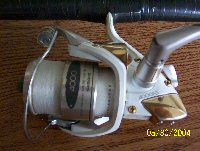 Reels/Line: There is an abundance of good reels (both casting & spinning)
on the market today. Several years ago I settled in with Shimano
reels and that is all that I use today. I especially like the Stradic
reels that Shimano makes. All the Stradic’s are made with 5
ball bearings and have proven over the years to be the smoothest
most dependable reels I have ever owned. I use the Stradic 4000 which
has a 5.7:1 gear ratio on my fluke rods. I spool one with 10 pound
test P-Line and the other with 8/20 Berkley Fireline.
Reels/Line: There is an abundance of good reels (both casting & spinning)
on the market today. Several years ago I settled in with Shimano
reels and that is all that I use today. I especially like the Stradic
reels that Shimano makes. All the Stradic’s are made with 5
ball bearings and have proven over the years to be the smoothest
most dependable reels I have ever owned. I use the Stradic 4000 which
has a 5.7:1 gear ratio on my fluke rods. I spool one with 10 pound
test P-Line and the other with 8/20 Berkley Fireline.
 The
reason for 2 different lines is this (1) Fireline: The Stradic 4000
will handle up to 12lb test mono line very easily-over that I believe
the performance of the reel drops of rapidly. There are times when
I need more line strength and sensitivity. When I’m fishing
boat docks and heavier cover many times I can’t see the Fluke.
I need a line that is super sensitive and has zero stretch, that’s
the reason for the Fireline. I can spool up with 8 lb diameter line
but have 20 lb test strength. I have also found that a fluke will
fall much slower on Fireline, and there are times that this is a
big plus. (2) P-Line 10 lb mono: First of all let me say that P-Line
is limp but very tough and is one of the most abrasion proof mono
lines that I have ever used. I use the P-Line when fishing the fluke
around bridge pilings-grass beds with little heavy cover and rip
rap areas where I can keep good eye contact with the bait. Where
the braided line makes the fluke fall slower-the P-line let’s
it fall faster and once again there are times when this works much
better for me.
The
reason for 2 different lines is this (1) Fireline: The Stradic 4000
will handle up to 12lb test mono line very easily-over that I believe
the performance of the reel drops of rapidly. There are times when
I need more line strength and sensitivity. When I’m fishing
boat docks and heavier cover many times I can’t see the Fluke.
I need a line that is super sensitive and has zero stretch, that’s
the reason for the Fireline. I can spool up with 8 lb diameter line
but have 20 lb test strength. I have also found that a fluke will
fall much slower on Fireline, and there are times that this is a
big plus. (2) P-Line 10 lb mono: First of all let me say that P-Line
is limp but very tough and is one of the most abrasion proof mono
lines that I have ever used. I use the P-Line when fishing the fluke
around bridge pilings-grass beds with little heavy cover and rip
rap areas where I can keep good eye contact with the bait. Where
the braided line makes the fluke fall slower-the P-line let’s
it fall faster and once again there are times when this works much
better for me.
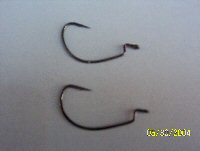 Hooks: When
it comes to hook selection I keep it very simple. I use a either
a #4 or a #5 Owner Wide Gap Plus hook period. These hooks are super
strong and you will never have to worry about having one get straightened
out by a big fish. For those of you that have other big species of
fish like Stripers in your lake these hooks will solve your problem.
Your line will break before these will bend. Not only are they strong
but they have a 3 sided cutting point that gives you great hook ups
with a Fluke. The reason for the 2 sizes is simple-the #4 weighs
less than the #5 and is what I use when I’m fishing the fluke
in a slower falling presentation. The #5 on the other hand weighs
more and I use this when the fall is faster.
Hooks: When
it comes to hook selection I keep it very simple. I use a either
a #4 or a #5 Owner Wide Gap Plus hook period. These hooks are super
strong and you will never have to worry about having one get straightened
out by a big fish. For those of you that have other big species of
fish like Stripers in your lake these hooks will solve your problem.
Your line will break before these will bend. Not only are they strong
but they have a 3 sided cutting point that gives you great hook ups
with a Fluke. The reason for the 2 sizes is simple-the #4 weighs
less than the #5 and is what I use when I’m fishing the fluke
in a slower falling presentation. The #5 on the other hand weighs
more and I use this when the fall is faster.
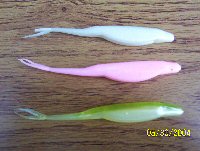 Fluke
Colors: Just like plastic worms and lizards Fluke type baits are
manufactured in as many colors as the rainbow. Some are solid in
color-some are 2 toned-some have glitter-some have scent added. But
once again I keep my color selection very simple. 80% of all the
fish I catch on a Fluke are caught on a 5 inch Pearl White Zoom Super
Fluke. The other 20% are caught on either a Bubblegum, Avocado and
Lemon Thread. I have well over 200 White Pearl Flukes in my boat
right now and will have to restock several times through the year.
Are there other colors that might work just as well? YES!!!!!! I’m
sure there are-BUT-these sure work for me!
Fluke
Colors: Just like plastic worms and lizards Fluke type baits are
manufactured in as many colors as the rainbow. Some are solid in
color-some are 2 toned-some have glitter-some have scent added. But
once again I keep my color selection very simple. 80% of all the
fish I catch on a Fluke are caught on a 5 inch Pearl White Zoom Super
Fluke. The other 20% are caught on either a Bubblegum, Avocado and
Lemon Thread. I have well over 200 White Pearl Flukes in my boat
right now and will have to restock several times through the year.
Are there other colors that might work just as well? YES!!!!!! I’m
sure there are-BUT-these sure work for me!
 Changing
Or Adding Color To You Fluke: There are times that I will “ADD
COLOR” to a Pearl White Fluke. When this happens it is normally
Red or Chartreuse. I use Spike It Dye to color the fluke in 3 different
ways. (1) I take a cotton q-tip dipped in the dye and color the slit
in the belly of the fluke (2) Dip just the head about ½ down
(3) Dip the tail about ½ inch down. I can’t always explain
it but there are times that red on a fluke will drive largemouth
nuts. Occasionally will use Spike It and entirely change the white
to solid Chartreuse. You may have a different color combo that will
for you ….but once again this sure works for me.
Changing
Or Adding Color To You Fluke: There are times that I will “ADD
COLOR” to a Pearl White Fluke. When this happens it is normally
Red or Chartreuse. I use Spike It Dye to color the fluke in 3 different
ways. (1) I take a cotton q-tip dipped in the dye and color the slit
in the belly of the fluke (2) Dip just the head about ½ down
(3) Dip the tail about ½ inch down. I can’t always explain
it but there are times that red on a fluke will drive largemouth
nuts. Occasionally will use Spike It and entirely change the white
to solid Chartreuse. You may have a different color combo that will
for you ….but once again this sure works for me.
Adding
a Good Quality Snap to the Fluke: Another change that can make a
big difference at times, is adding a good snap to your line. I always
use a #3 Fast lock Snap. I’m a firm believer that by adding
the snap you increase the side to side action of the Fluke. I have
also found that the snap will add a little extra weight but will
not make the Fluke “Nose Dive” when it falls. But please
let me warn you “Don’t Get Cheap” buy good snaps,
the difference is only a few pennies-but will payoff in bigger dividends.
Areas
To Fish A Fluke
In
this section we will discuss the following areas that pay off for me
when fishing a Fluke. (1) Bridge Pilings (2) Shallow Grass Beds (3)
Deep Grass Beds (4) Boat Houses/Boat Docks (5) Rip Rap Areas and (6)
Lay downs/Timber On Expansive Flats .
Bridge
Pilings: I believe that bridge pilings whether they are a main river
channel bridges or a secondary creek bridge are over looked by many
fishermen today. Most bridges 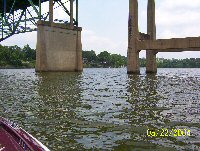 support
a variety of baitfish-crayfish-bluegill-crappie and other game fish
as well. A literal smorgasbord for hungry bass. I have had some great
trips on different lakes catching bass after bass running from one
bridge area to another through the course of the day. To help us
understand bridge pilings a little better let’s break this
explanation down into 2 parts (1) Open Pilings: most of these types
of pilings will have a shelf you cannot see that connects the columns
that support the bridge. If the bass are in this area most likely
they will be on or near this shelf. When fishing a Fluke in current
I try to put my boat upstream from the pilings and cast downstream,
by doing this you will maintain better lure control. Many times you
will find the current to be stronger toward the river channel and
less as you progress toward the bank. Be sure to work all 4 sides
of each piling and the shelf that connects them. At times the hit
on top will be fantastic-other times it may take letting the Fluke “Dead
Stick” around the pilings-always watch your line for the bass
to hit your bait on the fall. (2) Solid Pilings: Most of the time
shorter bridges that cross various creeks that feed the main lake
will have this type of pilling only. One attribute that a small bridge
has that larger ones don’t (because of its height) is that
it provides more shade to the structure directly below the bridge.
Most of these will have some degree of current and always seem to
have baitfish in some quantities around them. When fishing this type
of bridge and pilings concentrate on all 4 corner of the bank under
the bridge-the corners on the piling and make repeated casts directly
parallel down the entire length of the piling. Work the Fluke much
the same as we discussed above.
support
a variety of baitfish-crayfish-bluegill-crappie and other game fish
as well. A literal smorgasbord for hungry bass. I have had some great
trips on different lakes catching bass after bass running from one
bridge area to another through the course of the day. To help us
understand bridge pilings a little better let’s break this
explanation down into 2 parts (1) Open Pilings: most of these types
of pilings will have a shelf you cannot see that connects the columns
that support the bridge. If the bass are in this area most likely
they will be on or near this shelf. When fishing a Fluke in current
I try to put my boat upstream from the pilings and cast downstream,
by doing this you will maintain better lure control. Many times you
will find the current to be stronger toward the river channel and
less as you progress toward the bank. Be sure to work all 4 sides
of each piling and the shelf that connects them. At times the hit
on top will be fantastic-other times it may take letting the Fluke “Dead
Stick” around the pilings-always watch your line for the bass
to hit your bait on the fall. (2) Solid Pilings: Most of the time
shorter bridges that cross various creeks that feed the main lake
will have this type of pilling only. One attribute that a small bridge
has that larger ones don’t (because of its height) is that
it provides more shade to the structure directly below the bridge.
Most of these will have some degree of current and always seem to
have baitfish in some quantities around them. When fishing this type
of bridge and pilings concentrate on all 4 corner of the bank under
the bridge-the corners on the piling and make repeated casts directly
parallel down the entire length of the piling. Work the Fluke much
the same as we discussed above.
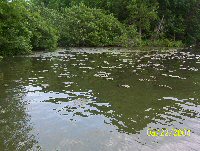 Shallow
Grass Beds: Grass has a way of holding bass. Even some of the shallowest
beds when fished early or late in the day can hold big numbers and
great quality fish. I’m speaking of depths from 1 foot to 5
feet deep. Some of the grass you can see-some you can’t. If
you are fortunate enough to be on the lake when it is overcast and
dreary the bite can last all day long in these shallow areas. The
most important factor is finding out where the bass are holding within
the grass. For instance I have noticed if you have a strong wind
blowing directly into the grass the fish seem to be more on the deepest
outside edges of the grass beds. If it is calm they can be scattered
anywhere from the bank in zero feet of water to the far outside edges.
Many grass beds will have an open area (no grass) from the bank out
several feet before the growth begins. These areas can hold large
quantities of fish, early and late in the day and on stormy overcast
conditions. When the bass are in this area I like to throw the Fluke
all the way up on the bank or sea wall and start from there….be
ready the strike can happen very quickly.
Shallow
Grass Beds: Grass has a way of holding bass. Even some of the shallowest
beds when fished early or late in the day can hold big numbers and
great quality fish. I’m speaking of depths from 1 foot to 5
feet deep. Some of the grass you can see-some you can’t. If
you are fortunate enough to be on the lake when it is overcast and
dreary the bite can last all day long in these shallow areas. The
most important factor is finding out where the bass are holding within
the grass. For instance I have noticed if you have a strong wind
blowing directly into the grass the fish seem to be more on the deepest
outside edges of the grass beds. If it is calm they can be scattered
anywhere from the bank in zero feet of water to the far outside edges.
Many grass beds will have an open area (no grass) from the bank out
several feet before the growth begins. These areas can hold large
quantities of fish, early and late in the day and on stormy overcast
conditions. When the bass are in this area I like to throw the Fluke
all the way up on the bank or sea wall and start from there….be
ready the strike can happen very quickly.
Deeper
Grass Beds: Many times grass beds that are adjacent to the main river
channels will provide visible surface vegetation on the channel edges
or flats. But there may also be an abundance of grass that will extend
out further that you will not be able to see visually. The visible
grass can provide (as we just discussed in the paragraph above) fantastic
action under certain circumstances. But when the day is bright and
sunny these areas can die off quickly. This is when you need to keep
your boat positioned in the river channel just far enough away where
you can make a good long cast to the shallow water. Let your Fluke
begin to drop down gradually along the outside edges of the vegetation.
At times we will work the Fluke much like a worm probing all depths
until we locate fish. Sometimes the bass will strike on the fall-other
times it will be when you move or twitch the bait.
Boat
Houses/Boat Docks: First let me say there is a vast difference between
a “Boat House” and a “Boat Dock”. Normally,
boat docks will have a walk way that varies in width, length and
configuration. Some times it will have a roof-other times not. A
boat house on the other hand is always covered and can be rather
large “Garage Looking” structure enclosed on at least
3 sides and many times all four. I have seen boat houses that had
as many as 6 slips in them.
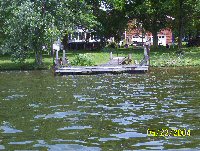
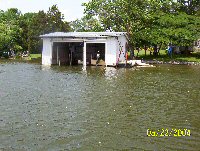 Although
these 2 structures look entirely different they do share some things
in common. Most of these will have some type of cable or strap that
attaches to the sides of the dock and then to the shore. Some will
have a “Boat Lift” system in the slip that has runners
or straps that are used to left the boat up out of the water. Some
will have smaller attached jet ski platforms that will be attached
to the side of the dock. Also many of these will have sunken brush
piles that the dock owner has placed there to attract fish to his
dock. If you’re fishing a new area that has docks watch for
floodlights-fishing pole holders-rods and chairs-all of these can
help you locate brush around docks. Also remember that most of these
sunken piles will be within a short cast from the dock. There are
other similarities but they all add up to the same thing-potential
holding places for bass.
Although
these 2 structures look entirely different they do share some things
in common. Most of these will have some type of cable or strap that
attaches to the sides of the dock and then to the shore. Some will
have a “Boat Lift” system in the slip that has runners
or straps that are used to left the boat up out of the water. Some
will have smaller attached jet ski platforms that will be attached
to the side of the dock. Also many of these will have sunken brush
piles that the dock owner has placed there to attract fish to his
dock. If you’re fishing a new area that has docks watch for
floodlights-fishing pole holders-rods and chairs-all of these can
help you locate brush around docks. Also remember that most of these
sunken piles will be within a short cast from the dock. There are
other similarities but they all add up to the same thing-potential
holding places for bass.
Let
Me Say This Before We Go Any Further. Always Pay Total Respect
To Others. Remember The Dock Or Boat House Is Someone Else’s
Property- Act Accordingly.
Many
people view cables-boat lift systems and jet ski platforms as obstacles
to their fishing. So consequently all they fish is both sides and
the front and then move on. What has happened at this point is they
have fished only 30% or less of the structure leaving 70% totally
untouched.
I
try to skip my Fluke in-between every opening-under every boat lifted
out of the water. In-between moored boat in the water and the sides
of the dock. I work my way around and skip the Fluke on the backside
of the dock between the dock and the shore. I like to pull right
up to the cables that hold the boat house or dock touching it lightly
with my trolling motor and skip the Fluke into every concealed area
as possible. If you’re working Boat Houses that provide a lot
of shade you will need to skip the Fluke as far back into the structure
as possible. Always watch your line because your Fluke will be out
of your eye sight.
I
remember a trip I had on Lake Bruin in Louisiana a couple years ago
with my oldest son Rick Jr. and TBGI’s Mike Dial. The bass
had moved all the way under boats lifted out of the water. These
boat house bass were holding right on the bank. We would have to
skip our baits altleast 18 to 20 feet back into the boathouse and
the bass would hammer the bait. Time after time we lifted 3lb to
5lb plus largemouth over the rail that was holding on this pattern.
If
you are fishing the brush around the dock and it is sunny and bright
you may have to let the Fluke sink down into the brush making contact
and work it much like you would a worm. If it is overcast the bass
will tend to hold more to the area between the brush and the dock.
When this happens many times you can have terrific blow ups on the
bait. Just some friendly advice-work these areas slowly-carefully
and be ready to set the hook at anytime.
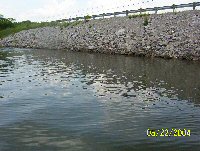 Rip
Rap Areas: Let me say right up-front “I like to Fish these
areas! This is one of my favorite types of structure to fish with
a variety of baits including a Fluke. These areas will hold a variety
of baitfish-sunfish and crayfish all year long. There are times when
bass-good bass will hold so close to the rip rap you will wonder
why you can’t see their fins, but they won’t chase a
bait. If you stay out away from the bank and throw in you might catch
one every now and then. When this happens your best bet is to parallel
the rocks so closely that you literally could step out of the boat.
Make good long casts and keep your bait within inches of the shore
line. Don’t get in a hurry-when you catch a fish stop your
forward movement and make repeated casts in the same area-chances
are there will be another fish there.
Rip
Rap Areas: Let me say right up-front “I like to Fish these
areas! This is one of my favorite types of structure to fish with
a variety of baits including a Fluke. These areas will hold a variety
of baitfish-sunfish and crayfish all year long. There are times when
bass-good bass will hold so close to the rip rap you will wonder
why you can’t see their fins, but they won’t chase a
bait. If you stay out away from the bank and throw in you might catch
one every now and then. When this happens your best bet is to parallel
the rocks so closely that you literally could step out of the boat.
Make good long casts and keep your bait within inches of the shore
line. Don’t get in a hurry-when you catch a fish stop your
forward movement and make repeated casts in the same area-chances
are there will be another fish there.
If
you are fishing rip rap that has irregular features such as points-big
cracks-logs and sunken brush you will want to key on these areas
and make repeated casts. BE PATIENT!!! I have spent several hours
fishing the same stretch of rip rap when bait fish are active and
caught fish after fish. You may have to sort through some smaller
fish at times but there are always good fish mixed in.
Lay
Down Timber On Flats: I realize that this might change from lake
to lake but here in middle Tennessee we have many lakes that have
expansive flats that are located close to deep water. These flats
will have a variety of vegetation, rock piles and lay down timber.
Some of this timber will float in and out with high water conditions
but much of it remains all the time. Most of these flats will have
an abundance of logs against the bank and some will have vegetation
around it-which is a bonus!
Last
year in the June-July and August when it was so hot that you would
have to either pour water on your head or put you hat in the water
just to cool off. TBGI’s Jon Simmons and I caught several hundred
bass with clients on flats much like what I described above. We had
to be very careful not to get to close to the logs because we would
kick up mud with our trolling motor. We would zero in on our target
and make long cast. We keyed on every log-grass bed and weed line
we could see. At times you couldn’t move the Fluke fast enough
and other times it would take a jerk and fall presentation. Like
we have all heard before “The Bass Will Tell You What They
Want”!
Something
else to keep in mind when fishing flats is to be on the look out
for isolated timber. If the concentration of timber is large enough
it can hold several bass not just one or two. Don’t rush in
on these areas be stealthy in your approach and make every cast count.
Rigging
And Fishing The Fluke
In
this section we will talk about 3 different methods to rig a fluke
and some basic techniques on fishing it.
 Texas
Style Rigging: This method is very easy. Hold the fluke in one hand
with the slit in the belly facing you. Insert the point of the hook
into the blunt end of the Fluke, bring the point out about half way
from the tip of the Fluke and the beginning of the slit. Push the
Fluke up the hook and over the bend, when this is done rotate the
Fluke 90 degrees until the point of the hook is facing the belly
slit. While holding the hook push the Fluke forward slightly then
insert the point of the hook into and through the Fluke until the
point is barely exposed. This method will keep you from getting hung
up in wood and grass. After a few casts and always after every strike
you will want to check you rigging out. There is nothing more aggravating
than being on fish in a small area and then getting hung up right
in the middle of it.
Texas
Style Rigging: This method is very easy. Hold the fluke in one hand
with the slit in the belly facing you. Insert the point of the hook
into the blunt end of the Fluke, bring the point out about half way
from the tip of the Fluke and the beginning of the slit. Push the
Fluke up the hook and over the bend, when this is done rotate the
Fluke 90 degrees until the point of the hook is facing the belly
slit. While holding the hook push the Fluke forward slightly then
insert the point of the hook into and through the Fluke until the
point is barely exposed. This method will keep you from getting hung
up in wood and grass. After a few casts and always after every strike
you will want to check you rigging out. There is nothing more aggravating
than being on fish in a small area and then getting hung up right
in the middle of it.
 Exposed
Texas Rigging: There maybe times when you can get away with this
method. The Fluke is rigged the exact same way with the exception
that the hook is left exposed outside of the Fluke. I fish a Fluke
in the manner at times along rip rap areas and bridge pilings when
there is an absence of logs and grass.
Exposed
Texas Rigging: There maybe times when you can get away with this
method. The Fluke is rigged the exact same way with the exception
that the hook is left exposed outside of the Fluke. I fish a Fluke
in the manner at times along rip rap areas and bridge pilings when
there is an absence of logs and grass.
 Wacky
Style Rigging: The first time I saw a Fluke fished this way was a
couple years ago with a client I had out. When I told him we were
going to fish a Fluke I asked him if he knew how to rig it. He replied
yes and I didn’t think any more about it. When we began fishing
at our first stop I watched him catch 5 largemouth in a row using
this method. It doesn’t take me long to catch on so I rigged
mine the same way and began to catch fish as well. There are times
this method works well. My only word of caution is, this method IS
NOT WEEDLESS in any manner shape or form. It needs to be used in
selected situations.
Wacky
Style Rigging: The first time I saw a Fluke fished this way was a
couple years ago with a client I had out. When I told him we were
going to fish a Fluke I asked him if he knew how to rig it. He replied
yes and I didn’t think any more about it. When we began fishing
at our first stop I watched him catch 5 largemouth in a row using
this method. It doesn’t take me long to catch on so I rigged
mine the same way and began to catch fish as well. There are times
this method works well. My only word of caution is, this method IS
NOT WEEDLESS in any manner shape or form. It needs to be used in
selected situations.
Fishing
A Fluke 101: First take a look at a Fluke. What is it suppose to
look like or represent when in the water? A shad…it is suppose
to look like a shad. I guess in my life time I have spent several
thousands of hours on the water. And through the years I have watched
shad dart and dive in a frenzy as they were dying. I have also watched
them sink ever so slowly straight down until they were completely
out of sight.
This
is my 2 basic retrieves that I want to emulate on a normal basis
when fishing a Fluke. At times I want the Fluke to dart and dive
quickly from side to side as if it was hurt and trying to get away
from a bass. There are times that I want the same motion but at a
reduced speed. And then there are times that I just “Dead Stick” the
bait and let it fall or settle down out of my sight.
Conclusion
Once
again the truth is “The Bass Will Let You Know” what they
want. Experiment-go to the lake and stand on a pier at a boat ramp
and practice these retrieves. Use your neighbors swimming pool when
their not watching. Watch how the bait responds rigged in the different
styles that I listed above. Watch what a difference it makes throwing
a Fluke on Fireline and then mono. Check out some of the structure
on your lake that I described above.
I
hope this helps you to have a better insight into fishing a fun bait..the
Fluke. As you fish them be sure to log onto my web site www.tennesseebassguides.com
go to the “FISH REPORT TAB” and give us an update on
how you did…or if you have questions ask them there and I will
respond to them.
As
always our goal is to be “THE” Bass Information Center
in middle Tennessee-thanks for taking time to read this article..Rick
McFerrin
More
Tips Tennessee Bass Guide

